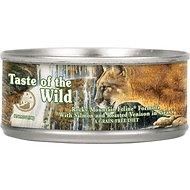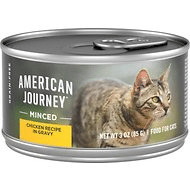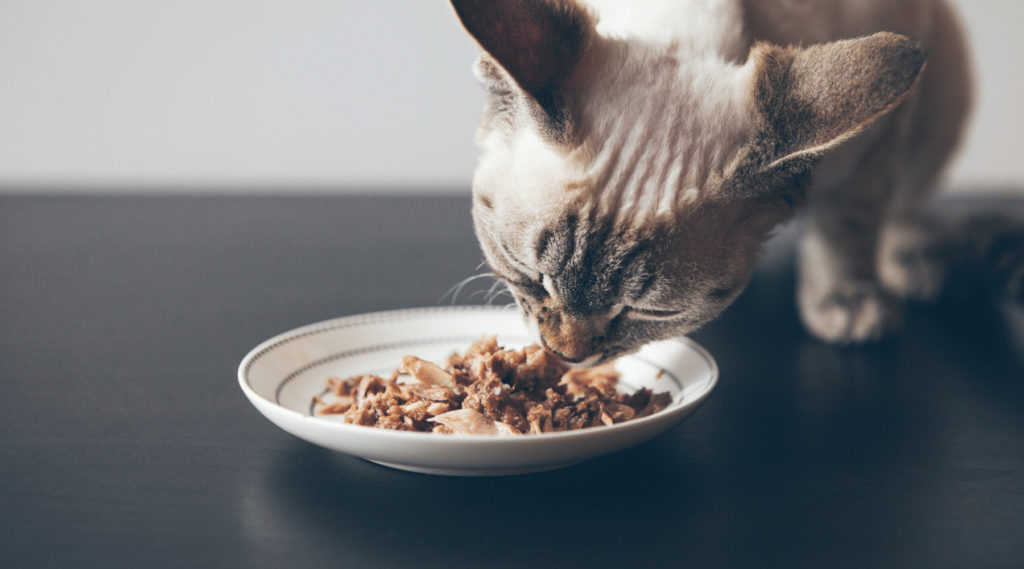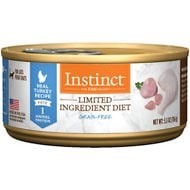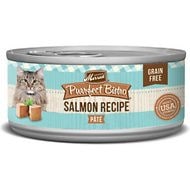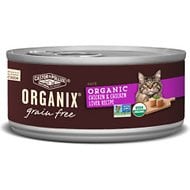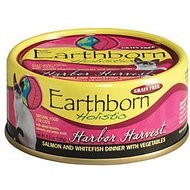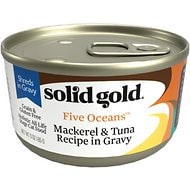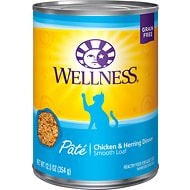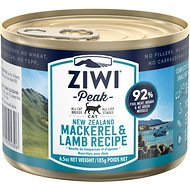Contents
- What Is The Best Food For Cystitis in Cats?
- What Exactly is Cystitis in Cats?
- What Causes FIC and How Do You Treat It?
- What to Look for in a Good Cat Food for Cystitis?
- How Do We Make Our Recommendations?
- The 10 Best Foods for Cystitis in Cats
- 6 More Top-Rated Cat Foods for Cystitis
- Merrick Purrfect Bistro Grain-Free Salmon Pate Canned Food
- Castor & Pollux Organix Grain-Free Organic Chicken Recipe Canned Food
- Earthborn Holistic Harbor Harvest Grain-Free Canned Food
- Solid Gold Five Oceans Mackerel & Tuna Recipe in Gravy Canned Food
- Wellness Complete Health Chicken & Herring Formula Canned Food
- Ziwi Peak Mackerel & Lamb Recipe Canned Food
- Frequently Asked Questions
Nothing is worse than getting out of bed and stepping in a fresh puddle of cat urine. When you find your cat urinating in unexpected places, your first instinct is probably to get mad. Eventually, your anger might fade to confusion – why would your cat pee on the floor when he has half a dozen perfectly good litter boxes? Don’t let the confusion stop there, however. If you truly care about your cat, you should take it one step further to concern.
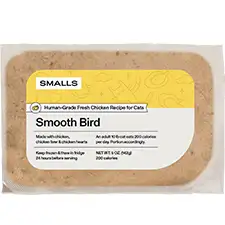
Smalls Human-Grade Ground Bird Fresh Cat Food
- Natural sources of taurine
- High in protein
Animals have a natural instinct to hide their pain, so you may not immediately recognize it when your cat is suffering. He can’t tell you outright what’s wrong, so you’re left looking for clues. Changes in behavior are some of the biggest clues your cat can give you that something is wrong and changes in litter box behavior are particularly telling. In many cases, changes in your cat’s litter box behavior are linked to feline lower urinary tract disease (FLUTD) or feline idiopathic cystitis (FIC).
In this article, we’ll explore the subject of cystitis in cats to help you learn what it is, what causes it, and how it can be managed. We’ll also explore the role diet can play in treating recurrent cystitis in cats to help you choose the best food for cystitis to try.
What Is The Best Food For Cystitis in Cats?
- Small Ground Bird Human-Grade Fresh Cat Food
- Taste of the Wild Canyon River Grain-Free
- American Journey Minced Salmon & Tuna Recipe
- Instinct by Nature’s Variety Limited Ingredient Diet
- Merrick Purrfect Bistro Grain-Free Salmon Pate
- Castor & Pollux Organix Grain-Free Organic Chicken
- Earthborn Holistic Harbor Harvest Grain-Free
- Solid Gold Five Oceans Mackerel & Tuna Recipe
- Wellness Complete Health Chicken & Herring
- Ziwi Peak Mackerel & Lamb Recipe Canned Food
What Exactly is Cystitis in Cats?
The term cystitis refers to inflammation of the urinary bladder and, in many cases, it has no known cause. This is referred to as feline idiopathic cystitis or FIC. Feline cystitis is fairly common in both male and female cats and isn’t usually a significant health concern. It can, however, be very uncomfortable for cats. Stress is thought to be the biggest contributing factor.
Though FIC is a disease in and of itself, it can also be linked to another condition called feline lower urinary tract disease (FLUTD). This is a term used to describe conditions affecting the urinary bladder and/or the urethra or lower urinary tract in cats. Feline idiopathic cystitis is thought to account for roughly two-thirds of cases of FLUTD.
Here are some of the most common symptoms of recurrent cystitis in cats:
- Straining to urinate
- Urinating more frequently
- Blood in the urine
- Urinating outside the litter box
- Licking the urinary opening
- Development of bladder stones
- Obstruction of the urethra
Unfortunately, there is no quick and easy diagnostic test to confirm a diagnosis of FIC. The only way to diagnose the issue is to rule out other recognized causes of FLUTD. This may involve analysis of urine samples, x-rays of the bladder, and potentially an ultrasound of the bladder. If these tests are sufficient to rule out other causes of FLUTD, a diagnosis of FIC can be confirmed.
What Causes FIC and How Do You Treat It?
Feline idiopathic cystitis can affect any cat, but certain cats have a higher risk for the condition. According to Dr. Julie Fischer, DVM, DACVIM, or Veterinary Specialty Hospital San Diego, high risk factors for FIC include the following:
- Male cats
- Young cats
- Overweight or indoor-only cats
- Cats with anxiety/nervous personalities
- Cats with a 50% or more dry food diet
- Cats in multi-cat households
By definition, feline idiopathic cystitis has no known cause. There are, however, several conditions and abnormalities that seem to be common in cats with FIC. Stress and abnormal responses to stress are major triggers for FIC. Examples include cats kept solely indoors and cats that share their environment with multiple other cats. Physiological abnormalities like defective bladder lining and neurogenic inflammation can also cause inflammation in the bladder.
When it comes to managing idiopathic cystitis in cats, the best treatment is a multifaceted approach. The goal is to reduce the likelihood of episodes of recurrent cystitis in cats. Drug therapy may be an option in some cases, such as anti-inflammatory drugs for cat cystitis, but FIC isn’t a particularly drug-sensitive disease. These drugs may appear to work at first but, in many cases, it is more likely that the symptoms have spontaneously resolved.
The best feline idiopathic cystitis natural treatment involves changes to the diet and environment. Increasing the cat’s moisture intake may help by encouraging more frequent urination and by diluting the urine. Adding polyunsaturated fatty acids to the diet may help reduce inflammation as well.
In addition to making changes to your cat’s diet, you may also want to make changes to his environment. Providing plenty of drinking options is a good start, and you should provide plenty of opportunities to urinate as well (at least one litter box for every cat). Indoor cats can also benefit from opportunities for stimulation and play, so make sure your cat gets plenty of attention and exercise. If you can provide safe access to the outdoors (such as an enclosed run), all the better.
What to Look for in a Good Cat Food for Cystitis?
When it comes to feline idiopathic cystitis, natural treatment is often the best option unless your veterinarian is able to identify a specific cause. For example, if your cat’s bladder issues are caused by an infection, you should treat the infection. In most cases, however, FIC is caused by stress and managing the condition involves increasing your cat’s moisture intake. Other than that, there are no specific nutritional requirements – you just need a healthy, high-quality cat food.
Here are some general things to look for in a good cat food for cystitis:
- Rich in moisture content. Increasing your cat’s moisture intake is the key to managing idiopathic cystitis in cats, so consider switching to a canned food or added a wet food topper to your cat’s diet. Most dry foods contain 10% moisture while wet foods have upwards of 78%.
- Plenty of premium animal proteins. Protein is the most important nutrient for any cat and it is most biologically valuable when it comes from animal sources. Meat, poultry, and fish should be the foundation of your cat’s diet, offering a minimum of 26% but ideally over 30%.
- Healthy animal-based fats. Fats provide your cat with a concentrated source of energy as well as essential nutrients. Polyunsaturated fats like omega-3 fatty acids offer anti-inflammatory benefits to reduce bladder inflammation. When paired with omega-6s they support your cat’s healthy skin and coat as well.
- Limited carbohydrate content. Cats have a limited ability to digest carbohydrates, so avoid any cat food that is too carb-heavy. Examples of digestible carbohydrates include whole grains, vegetables, and fruits. Generally speaking, wet cat food is lower in carbohydrates than dry food.
- Complete and balanced nutrition. A healthy and balanced diet is essential for all cats, so you should find a recipe that meets AAFCO requirements and contains necessary supplements to ensure balance. Don’t just rely on supplements, however – look for fresh fruits and vegetables as natural sources for key nutrients as well.
When switching your cat to a new food for managing idiopathic cystitis in cats, it’s important to take the transition slowly. Changing your cat’s diet too quickly could become an additional source of stress that might make matters worse. Start by adding a little of the new food to your cat’s current diet and gradually increase the amount of new food to replace the old food.
How Do We Make Our Recommendations?
Providing your cat with a high-quality diet is essential for his health and wellness. In cats with cystitis, there are no specific dietary requirements other than high moisture content. This gives you the freedom to choose from a wide range of different options, but you may be wondering what we recommend. Before we get to our top picks, we want to give you a little information about how we make our recommendations. First, know that we’d never recommend to you something we wouldn’t feel comfortable feeding our own cats.
Second, know that we make our recommendations based on the nutritional requirements of cats. We understand that cats are obligate carnivores which means that they have a biological requirement for a high-protein diet. Every recipe we recommend starts with a real animal-based protein as the main ingredient and may contain several supplemental proteins as well. We look for animal-based fats with a blend of omega-3 and omega-6 fatty acids as well as limited content of digestible carbohydrates. Our top picks are also complete and balanced with the help of essential nutrients.
Here are some of the general requirements for a cat food to receive our recommendation:
- A source of high-quality animal protein as the first ingredient
- At least 30% crude protein for kittens and at least 26% for adults
- A minimum of 9% crude fat for kittens and adults
- A balance of omega-3 and omega-6 fatty acids, primarily from animal sources
- A rich blend of nutrients from natural sources and supplements, as needed
- Limited carbohydrate content from digestible sources (like whole grains and veggies)
- No low-quality fillers, by-products, or artificial additives (preservatives, dyes, or flavors)
When reviewing cat food, the first thing we do is compare it to AAFCO food nutrient profiles. These profiles simply outline the minimum nutritional needs of cats in various life stages (kitten or adult). If a cat food meets these requirements, it will carry an AAFCO statement of nutritional adequacy on the package. It should look something like this: [X Product] is formulated to meet the nutritional levels established by the AAFCO Cat Food Nutrient Profiles for all life stages. After you have successfully determined that the formula is complete and balanced, you can go on to evaluating its quality.
The 10 Best Foods for Cystitis in Cats
The best food for cystitis is one that meets your cat’s nutritional needs through healthy, high-quality ingredients. Canned food is typically the best option because it is high in moisture which will support your cat’s bladder health, helping to minimize inflammation and reduce recurrent cystitis in cats. You have a wide variety of options to choose from, but we’ve selected a few recipes we think are worth considering. Here they are!
| Our 2024 Picks: Best Cat Foods for Cystitis | |||
Small Ground Bird Human-Grade Fresh Cat Food
|
CHECK PRICE | ||
Taste Of The Wild Rocky Mountain Grain-Free
|
CHECK PRICE | ||
American Journey Minced Chicken Recipe In Gravy
|
CHECK PRICE | ||
Instinct by Nature’s Variety Limited Ingredient Diet
|
CHECK PRICE | ||
Merrick Purrfect Bistro Grain-Free Salmon Pate
|
CHECK PRICE | ||
Castor & Pollux Organix Grain-Free Organic
|
CHECK PRICE | ||
Earthborn Holistic Harbor Harvest Grain-Free
|
CHECK PRICE | ||
Solid Gold Five Oceans Mackerel & Tuna Recipe
|
CHECK PRICE | ||
Wellness Complete Health Chicken & Herring
|
CHECK PRICE | ||
Ziwi Peak Mackerel & Lamb Recipe
|
CHECK PRICE | ||
Small Ground Bird Human-Grade Fresh Cat Food
Overall Best Food for Cystitis: When it comes to feeding your cat well, fresh food is an excellent option to consider. Many pet nutritionists advocate for raw food – they consider it closest to a cat’s biological diet. The problem with raw food is that it’s hard to keep fresh. Fresh food, on the other hand, is made from raw ingredients and cooked more gently than traditional kibble which preserves the nutritional integrity of the raw ingredients. Smalls is our favorite fresh pet food brand – they send pre-portioned packages of freshly prepared cat food right to your door. Simply provide some basic information about your cat’s age, weight, and activity level and they’ll determine his calorie needs and portion his meals accordingly. Smalls uses only high-quality, whole-food ingredients including premium animal proteins, whole grains, fresh fruits, and vegetables to deliver complete and balanced nutrition.
- Pros: High nutritional quality, real animal proteins, whole-food ingredients, gently cooked to preserve nutritional value, pre-portioned according to cat’s calorie needs
- Cons: Only two recipes to choose from, significantly more expensive than traditional kibble
Taste of the Wild Canyon River Grain-Free Canned Food
Most Popular Cat Food for Cystitis: Because there are no specific dietary requirements for cystitis other than moisture, you may have a tough time choosing a new cat food. If you’re not sure where to start looking, you can always go with a trusted brand like Taste of the Wild. This Canyon River grain-free canned food is a nutritious option rich in protein and moisture as well as essential nutrients. This formula features real trout as the main ingredient with other protein-rich sources like ocean fish and smoked salmon. It is packed with real fish flavor and loaded with healthy nutrients from natural sources as well as supplemented. It doesn’t contain any artificial additives but is supplemented with prebiotic fiber and probiotics to support healthy and regular digestion. Plus, it is made in the USA by a family-run company.
- Pros: Real trout first ingredient, rich in real animal protein, high moisture content, fresh fruits and vegetables, rich in omega-3 fatty acids, complete and balanced, highly digestible
- Cons: Contains some starchy ingredients (potato starch), main source of fat plant-based (sunflower oil)
American Journey Minced Salmon & Tuna Recipe in Gravy Grain-Free Canned Food
Most Affordable Cat Food for Cystitis: Good cat food can be expensive, but you don’t necessarily need to pay top dollar to feed your cat well. American Journey is a high-quality, affordable brand of pet food that offers a number of different choices. We like this Minced Salmon & Tuna Recipe in Gravy canned food for cats with cystitis because it is rich in moisture and made with high-quality, natural ingredients. Fresh salmon and tuna provide protein-rich sources of nutrition as well as omega-3 fatty acids for anti-inflammatory benefits. This recipe contains limited carbohydrate content from grain-free sources like peas and flaxseed as well as fresh fruits and veggies to provide natural sources for key nutrients. You’ll also find that it contains the necessary vitamin and mineral supplements to ensure complete and balanced nutrition.
- Pros: Rich in animal protein, high in moisture, blend of omega fatty acids, low carbohydrate content, complete and balanced nutrition, fresh fruits and vegetables for natural nutrient content
- Cons: First listed source of fat is plant-based (sunflower oil)
Instinct by Nature’s Variety Limited Ingredient Diet Grain-Free Real Turkey Recipe
Best Food for Cystitis and Sensitive Stomach: If your cat has a sensitive stomach, you need to be more mindful of what you feed him. A high-quality diet made with whole food ingredients is essential, but you should also limit the number of ingredients to reduce the risk for triggering a food allergy. This limited ingredient diet turkey recipe from Instinct by Nature’s Variety is a great option. It features a single source of animal protein which is novel for many cats, further reducing the risk for triggering an allergy. It contains just five primary ingredients aside from supplements as well. This formula is easily digestible and full of real animal protein and turkey flavor, making it highly palatable and gentle on sensitive stomachs.
- Pros: Single source of animal protein, limited list of ingredients, highly digestible, complete and balanced nutrition, chelated mineral supplements
- Cons: Contains some plant protein (pea protein)
6 More Top-Rated Cat Foods for Cystitis
Merrick Purrfect Bistro Grain-Free Salmon Pate Canned Food
To give your cat the gift of real fish flavor and high-quality animal protein, consider this Merrick Purrfect Bistro Grain-Free Salmon Pate Canned Food. This formula features real salmon as the first ingredient to support lean muscle mass while also providing natural omega-3 fatty acids for their anti-inflammatory benefits. It contains plenty of antioxidants from fresh fruits and vegetables with a delectable pate texture your cat will love. This recipe contains several supplemental proteins as well from fresh chicken, chicken liver, and eggs as well as salmon oil and flaxseed for a rich blend of omega-3 and omega-6 fatty acids for healthy skin and coat. Overall, this recipe is complete and balanced and packed with flavor.
Castor & Pollux Organix Grain-Free Organic Chicken Recipe Canned Food
It’s harder to get better than organic ingredients which is why we love this Castor & Pollux Organix Grain-Free Organic Chicken Recipe. This formula features organic free-range chicken as the first ingredient to deliver high-quality animal protein for strong, healthy muscles. You’ll also find wholesome veggies and fresh cranberries to deliver natural sources of key nutrients. This recipe is packed with omega-3 and omega-6 fatty acids for healthy skin and coat, but it’s completely free from artificial additives like colors, flavors, and preservatives. This recipe supports your cat’s digestive and urinary health by delivering plenty of moisture from real, flavorful broth and added fiber for healthy digestion.
Earthborn Holistic Harbor Harvest Grain-Free Canned Food
Made with a protein-rich blend of tuna, salmon, and whitefish, this formula is packed with anti-inflammatory omega-3 fatty acids. In addition to being loaded with omega-3s, real fish is an excellent source of biologically valuable protein to support your cat’s healthy muscles and lean mass. This recipe contains carrots, peas, and potatoes as highly nutritious sources of carbohydrate energy and key nutrients. You’ll also find sunflower oil to balance out the natural omega-3s, supporting your cat’s healthy skin and coat. Overall, this formula is loaded with high-quality nutrition from whole food ingredients and supplemented as needed for nutritional balance.
Solid Gold Five Oceans Mackerel & Tuna Recipe in Gravy Canned Food
Another excellent option in protein-rich canned food is this Solid Gold Five Oceans Mackerel & Tuna Recipe in Gravy. Made with real mackerel and tuna, this grain-free canned food is rich in moisture and highly digestible. It is completely free from by-products and artificial additives and contains a limited list of ingredients aside from supplements. With mackerel as a natural source of omega-3s and canola oil for omega-6s, this recipe supports your cat’s healthy skin and coat as well.
Wellness Complete Health Chicken & Herring Formula Canned Food
The Wellness brand is a high-quality choice for cat food and we like this Wellness Complete Health Chicken & Herring Formula for cats with recurrent cystitis. In addition to being loaded with moisture, it also packs a punch with protein and real flavor. This recipe is 100% grain-free for optimal digestion and it supports the 5 signs of cat wellness – lustrous skin and coat, healthy digestion, bright eyes and strong teeth, plenty of energy, and immune health. This formula contains antioxidant-rich cranberries and plenty of omega-3 fatty acids for their anti-inflammatory benefits.
Ziwi Peak Mackerel & Lamb Recipe Canned Food
Easily one of the top canned food brands on the market, Ziwi Peak offers plenty of protein-rich, low-carbohydrate formulas that are perfect for cats with cystitis. This Ziwi Peak Mackerel & Lamb Recipe Canned Food is particularly great because it contains mackerel as a main ingredient, a rich natural source of omega-3 fatty acids. This formula contains 92% fresh meat, organs, and New Zealand green mussels including whole, blue mackerel and grass-fed New Zealand lamb. Free from artificial additives and supplemented for complete and balanced nutrition, this formula is highly digestible, nutritionally balanced, and loaded with natural flavor.
Frequently Asked Questions
- What causes cystitis in cats? Though cystitis in dogs is often caused by infection, it is more commonly caused by stress in cats. In female cats, cystitis is largely a painful or uncomfortable condition, but it can actually become life-threatening for male cats if crystals block the urethra and prevent the passage of urine.
- Will cystitis in cats clear up on its own? Recurrent idiopathic cystitis in cats is often intermittent, meaning that the symptoms come and go. Some cats display only mild signs of discomfort that seem to go away on their own while others develop longer-lasting issues. There is no single treatment for FIC because it can be triggered by multiple things including stress. Your best bet is to increase your cat’s moisture intake, make sure there are plenty of litter boxes to choose from, and take steps to reduce stress.
- How long does cystitis last in cats? Cystitis is usually fairly mild in cats, but it can occur rather suddenly. In some cats, the symptoms persist for long periods of time but, in others, they may resolve within 5 to 10 days only to recur again later. Every case is different, but the symptoms should never be ignored. If you fail to take steps toward managing idiopathic cystitis in cats, your cat’s issues will continue to recur.
- Is wet food better for cats with cystitis? Generally speaking, wet food is higher in moisture content than dry food which is a benefit for cats with cystitis. Increasing your cat’s moisture intake will help increase urinary frequency and dilutes the urine to prevent inflammation from the accumulation of crystals. If your cat will eat wet food, that’s the simplest solution. Just be sure to do your research when selecting a new cat food to make sure it is a high-quality recipe that will provide for your cat’s nutritional needs.
- How can I get my cat to drink more water? Cats don’t tend to drink a lot of water anyway, but if your cat suffers from cystitis you need to find a way to increase his moisture intake. Switching your cat to wet food or adding a wet food topper to his dry food can help, but it may not be enough. Make sure there are plenty of water dishes around the house and consider using a pet fountain to keep the water fresh. When choosing water bowls, look for ones that are wide and shallow, so your cat doesn’t bump his whiskers on the sides.
Cystitis is a common condition in cats and generally fairly easy to manage because it isn’t a life-threatening condition. There are cases where the condition resolves on its own, but it may come back if you don’t manage the triggers. Recurrent cystitis in cats is common in multi-cat households and in cats where stress is a major factor. Do your best to make your cat’s environment the least stressful as possible and take steps to increase his moisture intake.
If you’re looking for the best cat food for cystitis, you have plenty of options to choose from. The key is to find a high-quality cat food made from premium natural ingredients with higher moisture content. As long as you meet those criteria, you can choose pretty much whatever you want. If you’re not sure where to start shopping, check out our list of the best cystitis cat foods above.

